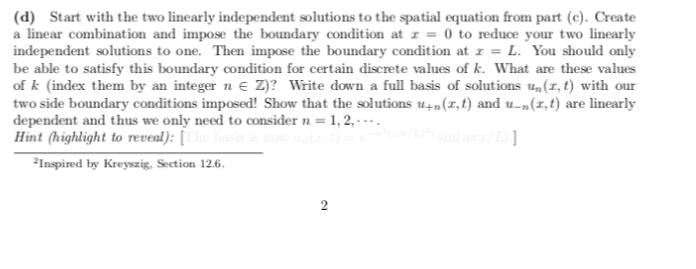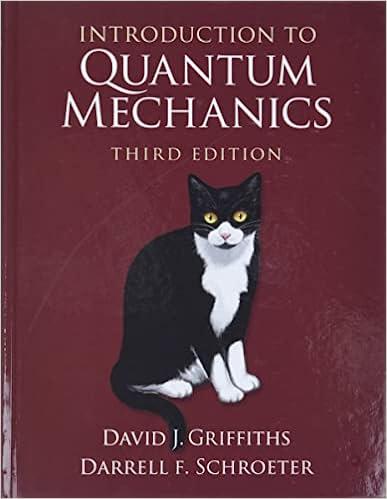Question
Start with the two linearly independent solutions to the spatial equation from part (c). Create a linear combination and impose the boundary condition at

Start with the two linearly independent solutions to the spatial equation from part (c). Create a linear combination and impose the boundary condition at z = 0 to reduce your two linearly independent solutions to one. Then impose the boundary condition at x = L. You should only be able to satisfy this boundary condition for certain discrete values of k. What are these values of k (index them by an integer ne Z)? Write down a full basis of solutions un(r, t) with our two side boundary conditions imposed! Show that the solutions un(x, t) and u_(r,t) are linearly dependent and thus we only need to consider n = 1, 2,.... Hint (highlight to reveal): [The hi Inspired by Kreyszig, Section 12.6. 2
Step by Step Solution
There are 3 Steps involved in it
Step: 1
The detailed ...
Get Instant Access to Expert-Tailored Solutions
See step-by-step solutions with expert insights and AI powered tools for academic success
Step: 2

Step: 3

Ace Your Homework with AI
Get the answers you need in no time with our AI-driven, step-by-step assistance
Get StartedRecommended Textbook for
Introduction To Quantum Mechanics
Authors: David J. Griffiths, Darrell F. Schroeter
3rd Edition
1107189632, 9781107189638
Students also viewed these Accounting questions
Question
Answered: 1 week ago
Question
Answered: 1 week ago
Question
Answered: 1 week ago
Question
Answered: 1 week ago
Question
Answered: 1 week ago
Question
Answered: 1 week ago
Question
Answered: 1 week ago
Question
Answered: 1 week ago
Question
Answered: 1 week ago
Question
Answered: 1 week ago
Question
Answered: 1 week ago
Question
Answered: 1 week ago
Question
Answered: 1 week ago
Question
Answered: 1 week ago
Question
Answered: 1 week ago
Question
Answered: 1 week ago
Question
Answered: 1 week ago
Question
Answered: 1 week ago
Question
Answered: 1 week ago
Question
Answered: 1 week ago
Question
Answered: 1 week ago
Question
Answered: 1 week ago
View Answer in SolutionInn App



